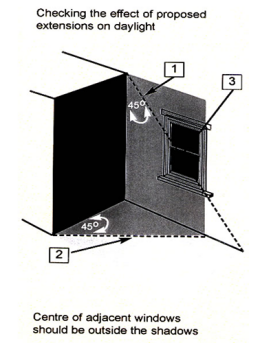Right to Light Explained
- The rights to light allow property owners to maintain consistent illumination through their windows.
- This does not apply to gardens, as the level of natural daylight is calculated in relation to the windows of your property.
- There are different methods of calculating the rights to light, including the 45-degree rule and the 50-50 rule.
Is there a right to light in the UK?
In the UK, the right to light is a type of easement which gives a long-standing owner of a building with windows the right to maintain the level of illumination.
It is based on the Ancient Lights Law of 1663, which stated that windows used for light by an owner for long periods could not be obstructed by the erection of an edifice or by any other act by an adjacent landowner. In the modern era, rights are normally acquired under the Prescription Act 1832.
During the conveyancing process, easements and covenants are subjects which are considered in the legal enquiries stage. This is where your solicitor checks out the legal deeds and the contract of sale for the house you are looking to buy.
What is the 20-year rule for the right to light?
Any building owner with windows that have received natural daylight for 20 years or more is entitled to forbid any construction or other obstruction that would deprive them of that illumination. Neighbours can't build anything that blocks the light without permission.
Once a right is established, an owner is entitled to "sufficient light according to the ordinary notions of mankind", which is interpreted as one foot-candle of illuminance or about ten lux for reading or tasks that require visual discrimination. Exactly how much light is needed, however, is frequently the subject of court disputes, with expert witnesses involved.
For example, imagine your family has lived in the same house for 25 years. You've always enjoyed a bright living room, thanks to large south-facing windows. If a new development blocks light from those windows, you may have a right-to-light claim, as you've had uninterrupted access to that light for over 20 years.
Can my neighbour block my sunlight?
This mostly depends on how much direct light your neighbour's development is obstructing. A general rule of thumb is if more than 50% is affected, then your right is breached.
Any kind of development might potentially block the light coming into your home. Some examples include:
- A neighbour’s new shed.
- Garden walls or fences.
- Extensions and conservatories.
- Part of a new housing or development.
- Landscaping and tree planting.
- Solar panels.
If your right of light hasn't been taken into account by a property developer, you might be entitled to claim compensation by way of remedy or to negotiate changes to the development which safeguard your light.
Extensions - a common cause of disputes
An examination of a local authority online planning portal regarding extensions gives the following information:
- Your extension should not result in a significant loss of privacy, daylight or sunlight to neighbouring properties, or be visually overbearing when viewed from adjoining houses.
- The use of side windows in extensions adjacent to boundaries should be avoided, as a view across adjacent land/gardens, or adequate light, cannot be assumed.
- The majority of houses have their main windows facing front and back. An extension built close to the boundary with a neighbouring property may therefore reduce daylight and sunlight to the windows of that house, together with the outlook from these rooms. Extensions should not, therefore, be so large as to create a claustrophobic effect or cause a significant amount of visual intrusion and loss of light to neighbouring properties.
- The Council has adopted the Building Research Establishment guidance on site layout planning for daylight, and extensions should comply with the 45-degree test.
The trouble is that homeowners often employ a local building firm to carry out their extension plans without knowing that development could affect their neighbours' rights to light. They rarely employ a specialist and the next thing they know, they receive a letter from a neighbour's solicitor.
Most commonly, problems arise when a neighbour has a window to the side of their house to which the light is blocked by a high wall.
Regarding rear extensions, including conservatories or orangeries, according to Government guidance, these shouldn't materially alter the existing levels of sunlight, privacy and daylight to adjoining properties.
If you think your right to light has been breached and you're in a proper dispute, consult a solicitor. SAM's panel of experienced solicitors can help with your case.
Book a FREE 15-minute meeting* with a specialist property dispute solicitor/consultant.
They'll listen to your issue and suggest ways forward, including the costs, with no obligation to use our services after the free meeting.
- What are my responsibilities?
- Who pays if a boundary wall is damaged?
- Mediation and Settlement Agreements
- Applications to court, including Declaratory Orders, Regulatory Orders, Occupational Rent
How do you calculate the right to light?

What is the 45-degree rule for the right to light?
The 45-degree light rule is usually used by local authorities when granting right-to-light planning permissions.
This calculates if the development will obstruct the natural light on the neighbouring properties' windows. If the development doesn't pass this test, the planning permission can be rejected.
- You take the elevation of the wall in which the neighbour's window is placed and draw diagonally down at an angle of 45 degrees away from the near top corner of the extension;
- You then take the plan and draw diagonally back at an angle of 45-degrees towards the window wall from the end of the extension;
- If the centre of the main window of the next-door property lies on the extension side of both these 45-degree lines, then the extension may well cause a significant reduction in the light received by the window.
What is the 50-50 rule for the right to light?
The 50-50 rule states that if the new development obstructs more than 50% of the natural light in the property, your right to light is breached, and you can make a complaint. This method is usually used by the courts when making an assessment.
We recommend you involve a structural engineer on any extension or structural work on a property. They will be able to make calculations that adhere to the 45-degree rule, and the 50-50 rule, and account for other factors which might not be readily apparent.
How do you prove right to light?
Irrespective of whether the right to light planning permission has been granted and depending on how bad the issue is if construction goes ahead on building development, then you can go to court to complain about the infringement of your right to light.
If the court finds in your favour, it can either:
- Award you compensation; and/or
- Cut back the offending part of the development.
In extremis, the court can issue an injunction stopping the development altogether.
A court, however, is unlikely to grant an injunction against a developer in cases where a small financial payment can be made as compensation – especially for minor matters or late applications.
The downside is that going to court is likely to be very expensive for you, particularly if you're seeking such an injunction.
Get a FREE* consultation for your right-to-light situation
If you think your right to light has been breached by a neighbour or new development nearby, we can help you.
Our experienced solicitors will listen carefully to your situation and advise on whether it's worth going to court or taking legal action.
Book through our online form below for your property challenge to be solved!
Andrew started his career in 2000 working within conveyancing solicitor firms and grew hands-on knowledge of a wide variety of conveyancing challenges and solutions. After helping in excess of 50,000 clients in his career, he uses all this experience within his article writing for SAM, mainstream media and his self published book How to Buy a House Without Killing Anyone.
Caragh is an excellent writer and copy editor of books, news articles and editorials. She has written extensively for SAM for a variety of conveyancing, survey, property law and mortgage-related articles.










